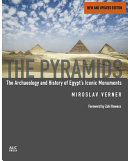

Most ebook files are in PDF format, so you can easily read them using various software such as Foxit Reader or directly on the Google Chrome browser.
Some ebook files are released by publishers in other formats such as .awz, .mobi, .epub, .fb2, etc. You may need to install specific software to read these formats on mobile/PC, such as Calibre.
Please read the tutorial at this link: https://ebookbell.com/faq
We offer FREE conversion to the popular formats you request; however, this may take some time. Therefore, right after payment, please email us, and we will try to provide the service as quickly as possible.
For some exceptional file formats or broken links (if any), please refrain from opening any disputes. Instead, email us first, and we will try to assist within a maximum of 6 hours.
EbookBell Team

5.0
80 reviewsAn authoritative account by preeminent Egyptologist Miroslav Verner covering over 70 of Egypt’s and Sudan’s pyramids, their historical and political significance, updated in a magnificent new edition
A pyramid, as the posthumous residence of a king and the place of his eternal cult, was just a single, if dominant, part of a larger complex of structures with specific religious, economic, and administrative functions. The first royal pyramid in Egypt was built at the beginning of the Third Dynasty (ca. 2592–2544 BC) by Horus Netjerykhet, later called Djoser, while the last pyramid was the work of Ahmose I, the first king of the Eighteenth Dynasty (ca. 1539–1292 BC).
Nearly two decades have passed since distinguished Egyptologist Miroslav Verner’s seminal The Pyramids was first published. In that time, fresh explorations and new sophisticated technologies have contributed to ever more detailed and compelling discussions around Egypt’s enigmatic and most celebrated of ancient monuments. In this newly revised and updated edition, including color photographs for the first time, Verner brings his rich erudition and long years of site experience comes to bear on all the latest discoveries and archaeological and historical aspects of over 70 of Egypt’s and Sudan's pyramids in the broader context of their more than one-thousand-year-long development.
Lucidly written, with 300 illustrations, and filled with gripping insights, this comprehensive study illuminates an era that is both millennia away and vividly immediate